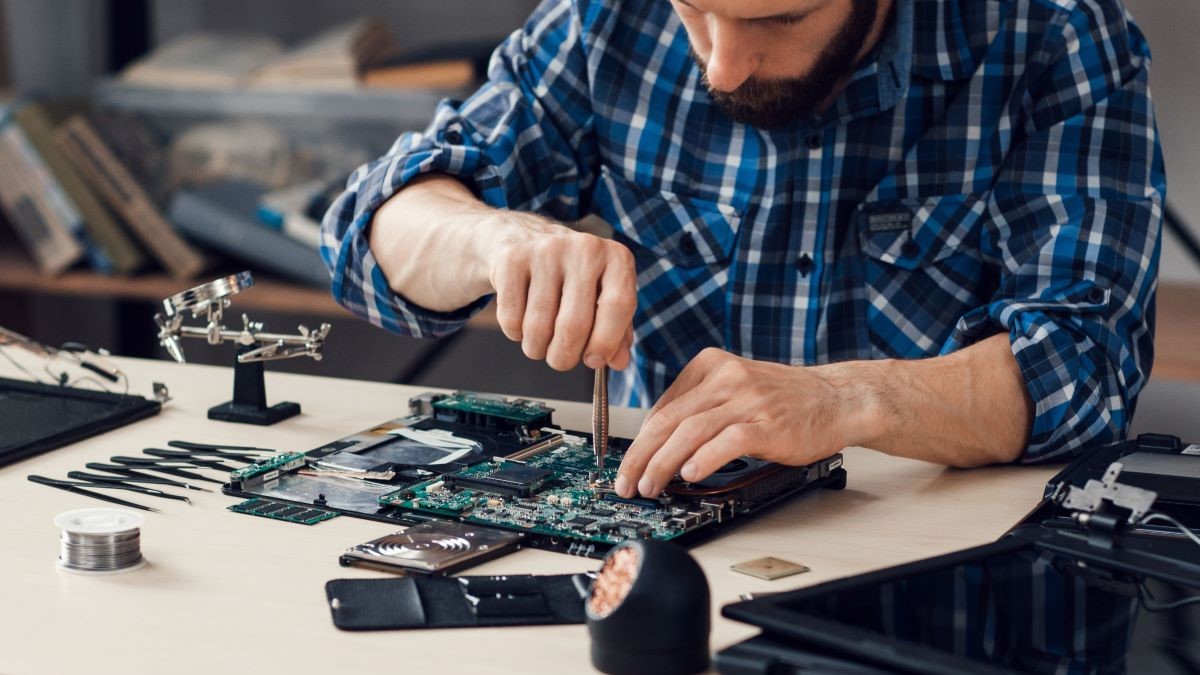Right now, it’s usually easier (and often less expensive) to replace an electronic device than to repair it. Even issues that seem simple, like switching out a faulty battery, can be impossible to do. It all adds up to piles of e-waste. What’s more, consumers usually end up eating the cost of replacing their devices. Fortunately, the “right to repair” movement is stepping in. Right to repair is an initiative determined to make it easier for consumers and small businesses to fix the devices and vehicles they use.
What is the right to repair?
If you own something, you should be able to do whatever you want with it, right? That’s the premise behind the right to repair movement. It’s essentially the idea that you should be able to mod, change, and fix your device as you see fit. It sounds simple and reasonable enough. In practice, though, it’s nearly impossible.
Consumer electronics companies have held their cards close to the chest for years. If your device does need repair, you typically have to go to company-owned repair shops, like the Apple Genius Bar. But if you don’t live near a city with an authorized repair facility, you might be out of luck. Third-party repair shops or individuals can’t get ahold of the information, parts, and tools for repairs.
Hardware is one thing. But the introduction of computer chips and internet connectivity throws another wrench in the mix. Without good repair options, consumers usually have to buy a new device if something needs to be replaced. It’s not sustainable for consumers or the environment.
So, the right to repair includes access to the information, tools, parts, and software that electronic devices run on. It also pushes for the ability to jailbreak devices. While that’s not legal at the moment, the right to repair movement believes it’s necessary. Legalized jailbreaks will allow repairmen to unlock, adapt, and modify parts of a device, including the software. Finally, right to repair supporters want companies to design products with the environment in mind. That means building devices that can be easily fixed, extending the product’s life, and allowing many users to enjoy the device through resale.
For and against the right to repair
Many large companies at the center of the right to repair debate cite concerns over consumer safety and cybersecurity risks. They say allowing third parties to work on devices opens consumers up to fraud and data theft. They’re also concerned about exposure of propriety information and trade secrets.
Supporters for the right to repair disagree with cybersecurity concerns. It’s not that internet-connected devices don’t have security risks—they do. Still, without the right to repair, third parties and consumers can’t fix vulnerabilities themselves, and many consumer electronics companies won’t repair those issues.
What’s more, advocates believe companies are monopolizing the repair and support for their products. By imposing repair limits, it’s easier for companies to control the products they produce. But it also benefits those companies over third-party repairs and consumers.
The right to repair movement creates opportunities for small business owners too. We’ve already seen this play out, by the way. There are plenty of independent auto shops and specialty repairers for everything from sewing machines to vacuum cleaners. The same scenario could also work for consumer electronics. Local third-party repair shops could fix smartphones, laptops, IoT devices, and more.
Finally, it comes down to the issue of the environment. It’s not exactly a secret that tech companies use planned obsolescence to push consumers to buy the latest and greatest. While that’s great for the tech industry, it adds up to a lot of e-waste, which is not-so-great for the planet.
What’s on the horizon
The right to repair movement is gaining momentum, led by The Repair Association. In July of 2021, the Federal Trade Commission (FTC) voted unanimously to uphold the right to repair. In the same month, President Biden also announced an Executive Order removing restrictions for third-party and self-repairs on items and equipment. And in November of 2021, Apple announced the release of parts, tools, and manuals starting with the iPhone 12 and 13 for consumers. It will allow consumers to repair some of their most common smartphone issues, like screens, batteries, and cameras.
There’s also been some notable legislation passed. Over half of the states in the Union had active right to repair bills in 2021, and most received bipartisan support. The movement seems to be picking up steam. Sonos and Microsoft electronics companies are beginning to say that they will make it easier to repair their products in the future. And the movement is going global, too.

How to repair your devices and support the right to repair
Want to get involved? You can start by repairing your own devices to save them from ending up in a pile of e-waste.
- To find a local third-party repair shop for your electronic devices, visit The Repair Association’s database of repair advocates.
- To get your hands dirty, check out iFixit. They have guides to fix everything from appliances, gaming consoles, and computer hardware. They also offer fix kits and parts so you can repair your devices.
- If you’re a repair whiz, you can make repair guides to help other people fix stuff.
- When you buy a new device, vote with your dollar and choose one that’s easy to repair. iFixit has a ranked list of smartphones, laptops, and tablets to choose from.
To learn more about the possibilities of the internet and our connected devices, check out the Learn section of the Quantum Fiber blog, which includes topics like:








